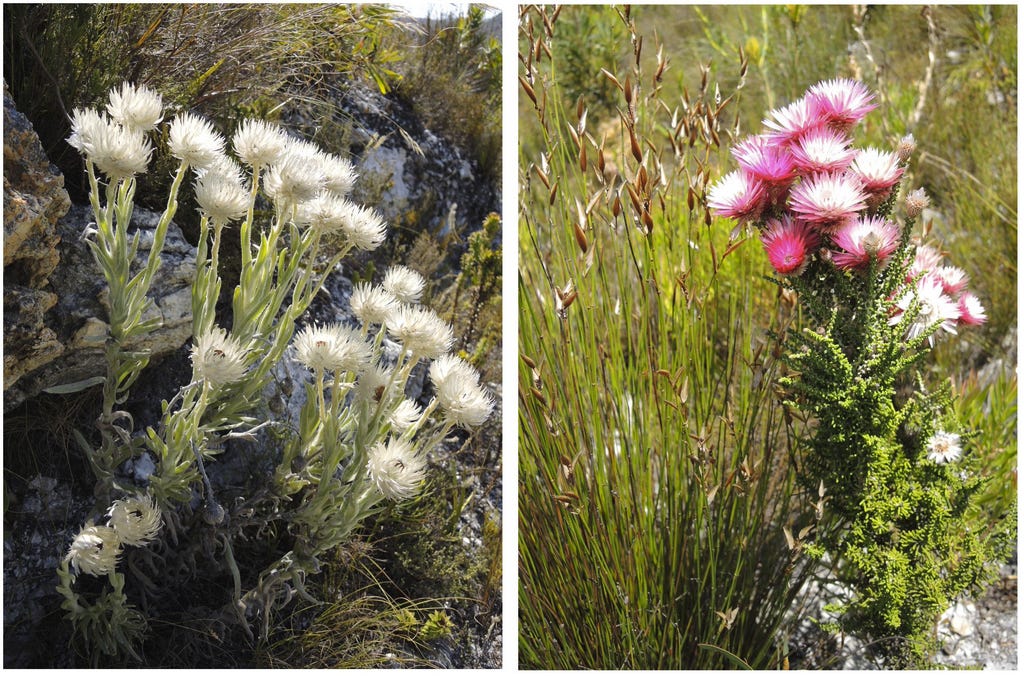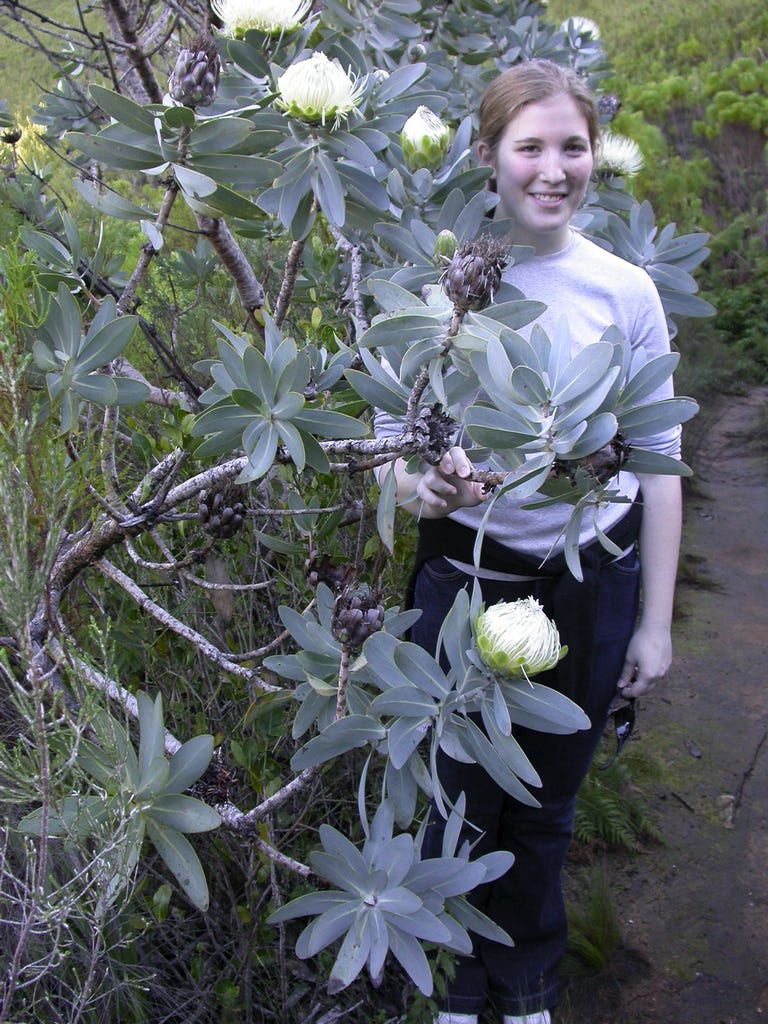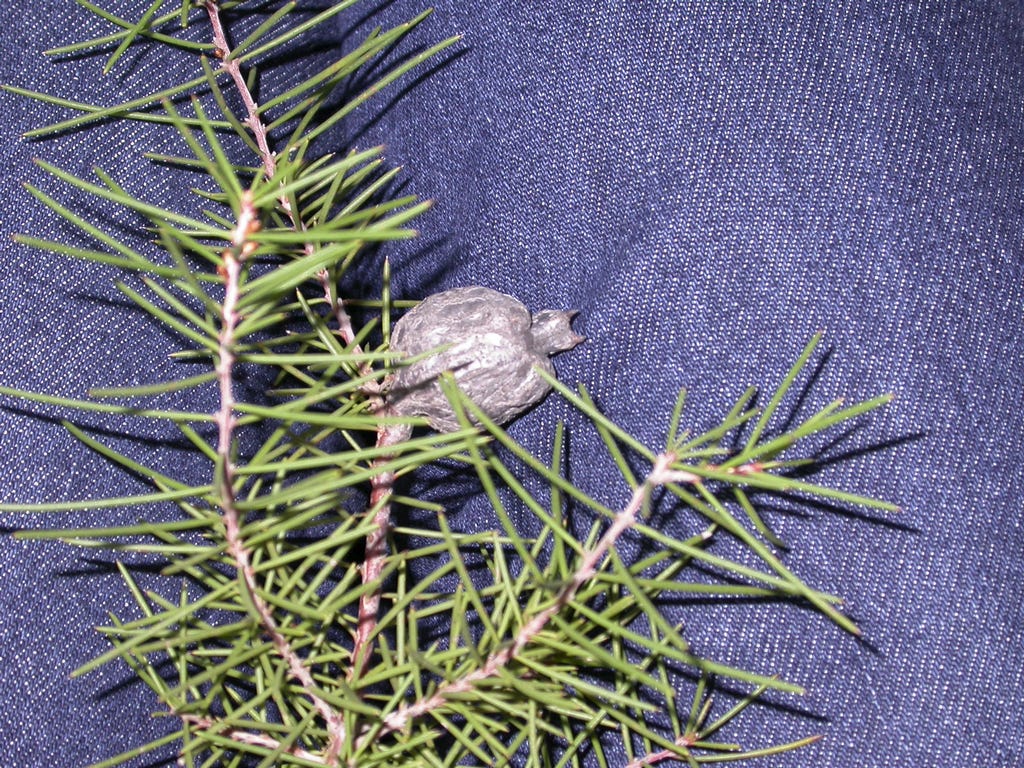In memory of my friend Cliff Moran (1937-2023), whose research helped control so many invasive weeds in southern Africa and elsewhere.
Fynbos (pronounced, fine-bos) is an Afrikaans word applied to the chaparral-like, shrubby vegetation that covers most of the mountain-and-valley region of the southern Cape Province. To most people, this is a region of vineyards and grain-fields, Cape Dutch architecture and lovely vistas, of rocky coastlines and sandy coves, home to Capetown and the Garden Route. To the unanointed, the natural vegetation that covers much of the mountains appears to consist of a lot of bushes. A very lot of bushes. Bushes as far as the eye can see, and then some. Perhaps many would agree with early settlers who said, “So where are all the trees, already?” when they first viewed this treeless landscape. Practically all the many kinds of trees now growing in the Cape region came from somewhere else, and many will be familiar to European, American and Australian visitors. Yet, this landscape of boring bushes is, in reality, a botanical miracle without parallel. It’s hard to improve on the perspective given in the foreword of the book Fynbos, by R. Cowling and D. Richardson, who wrote:
The Cape fynbos is a wonder of the world. It makes up four-fifths of the Cape Floral Kingdom which covers an area of less than 90,000 square kilometres—comparable with Malawi or Portugal—and hosts 8,600 plant species, 5,800 of which are endemic. To put this in perspective, the British Isles, three and a half times larger, have only 1500 plants, fewer than 20 of which are endemic. The whole of tropical Africa harbours 30,000 plant species in almost 20 million square kilometres--- only 3.5 times as many species in an area 235 times as large. Still more remarkable is the Cape Peninsula with its 2285 plant species in an expanse smaller than that of London. Table Mountain alone has almost 1500 species in 57 square kilometres. So super-special is the Cape Floral Kingdom that it has been designated one of the earth’s six plant kingdoms, putting it on a par with the Boreal Forest Kingdom, which covers 50 million square kilometres.
Yet this extravagance of life’s diversity is little known outside South Africa (and not always within it). … [F]ew people appreciate the wonder that is the Cape--- even though many Cape plants, such as geraniums, have become household adornments worldwide. The Cape Floral Kingdom contains 526 of the world’s 740 erica species, with their glorious flowers; 96 gladiolus species out of the world’s 160; and 69 proteas out of 112 on earth. The Cape is indeed a global epicentre of biodiversity.
Although my visit to the Cape region is short, I want to spend some time among the ericas, the restios and the proteas. Cliff and Peggy propose we will spend the day on Cape Peninsula, home to the Cape of Good Hope, a penguin colony and some of the finest fynbos in the hemisphere. The heavy overcast turns into a drizzle, which, as we head south, seems to wax more enthusiastic in the rain department. In and out of showers we drive, each one obscuring the view of Table Mountain to our left and each one a little wetter than the previous. With a great display of decisiveness, we make a U-turn and head north. Within 10 km, the rain is behind us, and although some of the peaks ahead are crowned in clouds, the sun shines between. It is a textbook demonstration of the climatic differences that distinguish the Cape Region from all the rest of southern Africa. A narrow zone along the southern coast of Africa, perhaps 30 to 50 miles wide catches the Antarctic weather fronts in the winter, but not summer. The result is a classic Mediterranean climate with gentle winter rains, and long, very dry summers. As in parts of the Mediterranean, in California, western Australia and coastal Chile, such climates are not fit for trees and seem to bring about the evolution of a shrub-dominated vegetation, well-adapted to recurrent fire. And here, just for my visit, the Great God of the Fynbos had just set up a most effective demonstration.

Through Stellenbosch toward Paarl and Franschoek we drive, an area justly famous for its charming scenery, colonial era estates and fine wine. A number of the towns date from the 1600s, old enough for me. Onward into the mountains. A very winding drive through a narrow canyon on a skinny ribbon of asphalt reveals mountainsides cloaked in subtle shades of green, chartreuse, gray and brown. The cover is not dense enough to hide the sandstone bones of the mountains’ slopes and combs.
We stop at the pass where a handful of houses perch in the saddle. A small hotel-resort offers special weekend deals-- booze and snooze (no one with any desire to live would try that canyon road drunk). The canyon behind us is already in shade. Lower down the slopes ahead, large, dark blocks of pines and eucalyptus have been planted, obliterating the fynbos. The boxy, uniform, dark green blocks of trees are jarring in this landscape of subtle textures and shades. Unlike the fynbos, they project from the land rather than cloaking it in a conforming skin.
The fynbos, especially when it is not in bloom, does not stand up and shout for attention. Appreciation requires close inspection and personal involvement over several seasons, but all we have today is the rest of the afternoon. We leave the car at the pass, and head up a trail along a ridge. Switching back and forth on the trail, the sun strikes us full-face, then disappears behind the ridge, then reappears, over and over. The sandstone crumbled from the mountain crunches underfoot, very pale with iron streaks here and there. The soils that weather from this stone are very poor and sandy, low in anything a plant might need. Here and there, an impervious, invisible concretion layer makes boggy places, leaking water, acid and stained like tea, the stuff of heaths. Close up, the bushes that make up the fynbos look delicate, many with very fine leaves (hence the name), fine branches, a few more robust and emerging from the knee-level crowd. Here and there stand larger Proteas luring both bird and insect pollinators with their huge, complex blossoms. There are even mouse-pollinated plants.

I ask Cliff this and that about the fynbos all around us. Waxing enthusiastic, he says, The fynbos is so precisely adapted to local conditions that there are some places where two very different soil types share a sharp boundary and you can stand with one foot in one soil type and the other in the other soil type, and the fynbos growing on both sides each contains hundreds of species, and I kid you not, Walter, they don’t have more than a dozen in common. It boggles the mind. He gives me an intense look. Peggy looks bemused. She is familiar with this speech.
Oddly, this extreme diversity is not readily visible. Many species of shrubs can only be discriminated by the flower, and few are in flower on this winter day. The casual observer that sorted the flowerless shrubs into types might come up with 20 or 30 different types, not the hundreds that actually grow in many places.
So it comes to this: people often think that a rich diversity of life is born of generous, ebullient conditions, and in their minds, conjure up images of the excesses of the tropical rain forests. But here in the fynbos, an astonishing diversity of life has been born not of generosity, but of adversity. Deprived of nutrients, on hostile soils, subjected to frequent incineration and deprived of rain for the nine hottest months of the year. Here, trees are not even starters. Perhaps such unforgiving conditions can be met only through very specific adaptations, challenge by challenge, until each species can thrive only under its particular combination of exposure, soil, nutrients, fire and water. Such very local adaptation could not be achieved, however, if plants interbred across large distances, or dispersed their seeds to the far reaches of the realm. No, for adaptation to be local, the flow of genes into and out of the neighborhood must be very low. In the fynbos, insects are the accomplices in this parochialism. Pollinators carry pollen only to nearby flowers. Once the seeds are ready, a large fraction of fynbos plants depend upon ants to disperse them, and even produce special attractive attachments on their seeds that ants are fools for. Ants, of course, are strictly pedestrian, and never travel far. Once the seed is in the nest, the ants gnaw off the tasty appendage, and thereafter treat the remaining seed as trash, or simply ignore it. But for the plant, a mission has been accomplished--- its seeds are now sequestered in places where they will be safe from the next fire, and out of the way of marauding rodents, and that place is not so far that the seed will germinate under conditions unsuitable to it.
Back on the road, we stop at an overlook. I want to show you this, says Cliff. The fynbos on the slope below us looks more uniform than typical, and consists of a blanket of dark green, head-high bushes. This, says Cliff, is Hakea, an exotic proteacea from Australia, the part of western Australia that has a climate like ours. It’s capable of invading fynbos, and burning only makes the problem worse because the fires are so hot that a lot of the root crowns and seeds of native species are killed. The Hakea, on the other hand, dumps zillions of seeds from rock hard receptacles which the fire causes to open. So instead of a moderate fraction of Hakea, a fynbos stand can be converted to a monoculture after one fire.
Sounds like the death knell for the fynbos, I say. Well, not quite, says Cliff. See all the gnarly knots? Those are the cankers of an indigenous fungus that we developed as a biocontrol agent. The bushes make so many cankers that all their strength is spent on cankers and none is left over for making seeds. The next time the fire incinerates this slope, Hakea will not come back. My gaze drifts down the long slope to where the fynbos ends at a pasture fence. A lot of Hakea is going to bite the dust sometime soon.
Cliff continues, we could cause the disease in Hakea by inoculating the plants with fungal spores, but we couldn’t get it to take in the wild. It was really frustrating. Finally, he explains, Johnny removed the shot from a dozen shotgun shells, dusted the shot with fungal spores, reassembled the shells, and then stood in the middle of a stand of Hakea and fired into it. Turned 30o, fired again. Thirty degrees and again, until all dozen shells were spent. The disease took.
I picture the scene in my mind, Johnny pumping the next shell into the chamber, clack clack, squinting down the barrel at a Hakea thicket. Was his an act of desperation, or perhaps genius? Did he feel pleasure, anger, or frustration, as he raised the barrel? Today, I have caught a glimpse of the fynbos’ delicate beauty, and gotten a taste of the struggle for existence that created it, and the forces that menace it. Yes, I say to myself, Johnny fired in anger.







What a wonderland! Thanks for describing it so eloquently and for giving the reader a glimpse into the genius of Cliff Moran. His keen observational skills and ingenuity remind me of you.
Wonderful and fascinating, Walter. Thanks, including gratitude for Cliff.
With all of that herbaceous diversity, besides ant diversity I’m wondering if it was immediately or obviously clear to you that the fynbos exhibited, overall, unusually high invertebrate diversity and abundance.